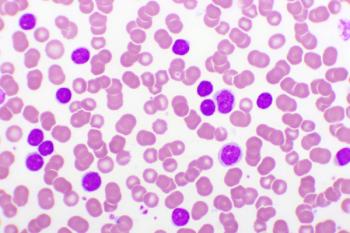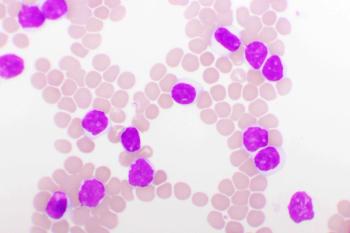
Real-world evidence highlights the effectiveness of lisocabtagene maraleucel in treating relapsed or refractory chronic lymphocytic leukemia (R/R CLL).
Jared is a freelance writer for The American Journal of Managed Care® (AJMC®), and previously worked as a senior editor for HCPLive® at MJH Life Sciences®.
He has an MA from University of Sioux Falls. You can connect with Jared on LinkedIn.

Real-world evidence highlights the effectiveness of lisocabtagene maraleucel in treating relapsed or refractory chronic lymphocytic leukemia (R/R CLL).

Chronic inducible cold urticaria is rare, but a new study suggests it can have significant impacts on patients’ daily lives.

With a follow-up of up to 6 years, the median progression-free survival for long-term extension participants was 52.5 months.

The benefit of trabectedin plus olaparib to all-comers with soft tissue sarcoma was marginal, but the response was more pronounced in certain subgroups.

Patients with DLBCL who were treated with R-CHOP and quickly relapsed or were refractory to therapy had poor outcomes on second-line therapy.

The patient was a rare case of a patient with dedifferentiated liposarcoma and a high tumor mutational burden.

Developers say more accurate automated multiple sclerosis lesion segmentation can improve research and patient care.

There is no cure for chronic lymphocytic leukemia, but an array of new therapeutic strategies are improving outcomes for patients.

More than one-quarter of US adults have a risk factor for severe RSV infection, but their eligibility for the RSV vaccine depends on their age.

Global chronic lymphocytic leukemia incidence and mortality is declining, but the disease’s prevalence has increased modestly.

New research shows patients commonly take lower doses of nintedanib, and the majority are also taking immunomodulatory drugs.

In real-world usage, 97% of cases of cytokine release syndrome following treatment with lisocabtagene maraleucel happened within 15 days of infusion.

TAM receptors could emerge as promising therapeutic targets for rheumatoid arthritis, offering insights into immune regulation and potential treatment strategies.

Patients with elevated levels of multiple adipokines had the highest risk, the authors found.

New research comparing the safety profiles of the 2 multiple sclerosis therapies suggests ocrelizumab is associated with lower rates of all-cause hospitalization and hypogammaglobulinemia.

Combining genetic features with clinical data improved the performance of a pulmonary fibrosis prediction score for people with rheumatoid arthritis.

Chimeric antigen receptor T-cell therapies, along with bispecific antibodies, have changed the treatment paradigm for patients with relapsed or refractory mantle cell lymphoma.

A new analysis based on two prospective trials helps clarify the roles of chemotherapy and radiotherapy.

Immunoglobulin heavy chain variable is an important prognostic biomarker in chronic lymphocytic leukemia, but the authors of a new review say its role has yet to be fully understood.

The causes of financial hardship among people with rheumatoid arthritis are not necessarily based on the cost of disease-modifying therapies, according to new research.

Only about 2% of cases of rhabdomyosarcoma primarily arise from the chest wall, and such cases require careful planning.

An RNA-based therapeutic approach led to transient activation of telomerase activity in a model of pulmonary fibrosis.

Nerandomilast slowed disease progression at 2 doses compared with placebo among US participants in the trial.

The study underscores the importance of repeat testing in cases where myelin oligodendrocyte glycoprotein immunoglobulin G tests are borderline.

Though patients with type 2 diabetes or chronic kidney disease (CKD) face a greater risk of heart failure (HF) following acute myocardial infarction (AMI), patients without those comorbidities also benefit from empagliflozin.

Real-world data suggest metabolic dysfunction-associated steatotic liver disease is also associated with higher all-cause mortality.

Previous research has evaluated PD-1/PD-L1 immunotherapy in patients with extensive-stage small cell lung cancer (ES-SCLC), but research in the setting of limited-stage disease is sparse.

Radiomic assessment has been used to distinguish multiple sclerosis from similar disorders, and it might also be useful in identifying MS stages and subtypes.

A new analysis suggests links between ZRSR2 loss and JAK2 V617R disease progression are indirect and complex.

Cardiac adverse events were lower among patients taking zanubrutinib compared with ibrutinib in the real-world setting.

Published: May 18th 2025 | Updated:

Published: August 1st 2020 | Updated:

Published: November 13th 2025 | Updated:

Published: January 26th 2024 | Updated:

Published: August 25th 2025 | Updated:

Published: October 22nd 2021 | Updated:

259 Prospect Plains Rd, Bldg H
Cranbury, NJ 08512
© 2025 MJH Life Sciences®
All rights reserved.
